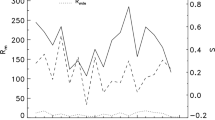Abstract
The ‘period-growth dichotomy’ of the solar cycle predicts that cycle 21, the present solar cycle, will be of long duration (>133 mo), ending after July 1987. Bimodality of the solar cycle (i.e., cycles being distributed into two groups according to cycle length, based on a comparison to the mean cycle period) is clearly seen in a scatter diagram of descent versus ascent durations. Based on the well-observed cycles 8–20, a linear fit for long-period cycles (being a relatively strong inverse relationship that is significant at the 5% level and having a coefficient of determination r 2 ≈ 0.66) suggests that cycle 21, having an ascent of 42 mo, will have a descent near 99 mo; thus, cycle duration of about 141 mo is expected. Like cycle 11, cycle 21 occurs on the downward envelope of the sunspot number curve, yet is associated with an upward ‘first difference’ in amplitude. A comparison of individual cycle, smoothed sunspot number curves for cycles 21 and 11 reveals striking similarity, which suggests that if, indeed, cycle 21 is a long-period cycle, then it too may have an extended tail of sustained, low, smoothed sunspot number, with cycle 22 minimum occurring either in late 1987 or early 1988.
Similar content being viewed by others
References
Eddy, J. A.: 1977, in O. R. White (ed.), The Solar Output and Its Variation, Colorado Associated University Press, Boulder, Colorado, p. 51.
Everitt, B. S.: 1977, The Analysis of Contingency Tables, Halsted Press (John Wiley and Sons, Inc.), New York.
Howard, R.: 1977, in A. Bruzek and C. J. Durrant (eds.), Illustrated Glossary for Solar and Solar-Terrestrial Physics, D. J. Reidel Publ. Co., Dordrecht, Holland, p. 7.
Langley, R.: 1971, Practical Statistics Simply Explained (revised edition), Dover Publ. Inc., New York.
McNish, A. G. and Lincoln, J. V.: 1949, Trans. Am. Geophys. Un. 30, 673.
Rabin, D., Wilson, R. M., and Moore, R. L.: 1986, Geophys. Res. Letters 13, 352.
Sargent, H. H., III: 1984a, Bull. Am. Astron. Soc. 16, 452.
Sargent, H. H., III: 1984b, Eos, Trans. AGU 65, 1072.
Swed, F. S. and Eisenhart, C.: 1943, Ann. Math. Statist. 14, 66.
Waldmeier, M.: 1961, The Sunspot-Activity in the Years 1610–1960, Schulthess and Co., Zürich, Switzerland.
Whitehouse, D. R.: 1985, Astron. Astrophys. 145, 451.
Wilson, R. M.: 1984, A Comparative Look at Sunspot Cycles, NASA Technical Paper 2325, Marshall Space Flight Center, Alabama.
Wilson, R. M., Reichmann, E. J., and Teuber, D. L.: 1984, Estimating Sunspot Number, NASA Technical Memorandum 86471, Marshall Space Flight Center, Alabama.
Author information
Authors and Affiliations
Rights and permissions
About this article
Cite this article
Wilson, R.M. On ‘bimodality of the solar cycle’ and the duration of cycle 21. Sol Phys 108, 195–200 (1987). https://doi.org/10.1007/BF00152088
Received:
Revised:
Issue Date:
DOI: https://doi.org/10.1007/BF00152088




